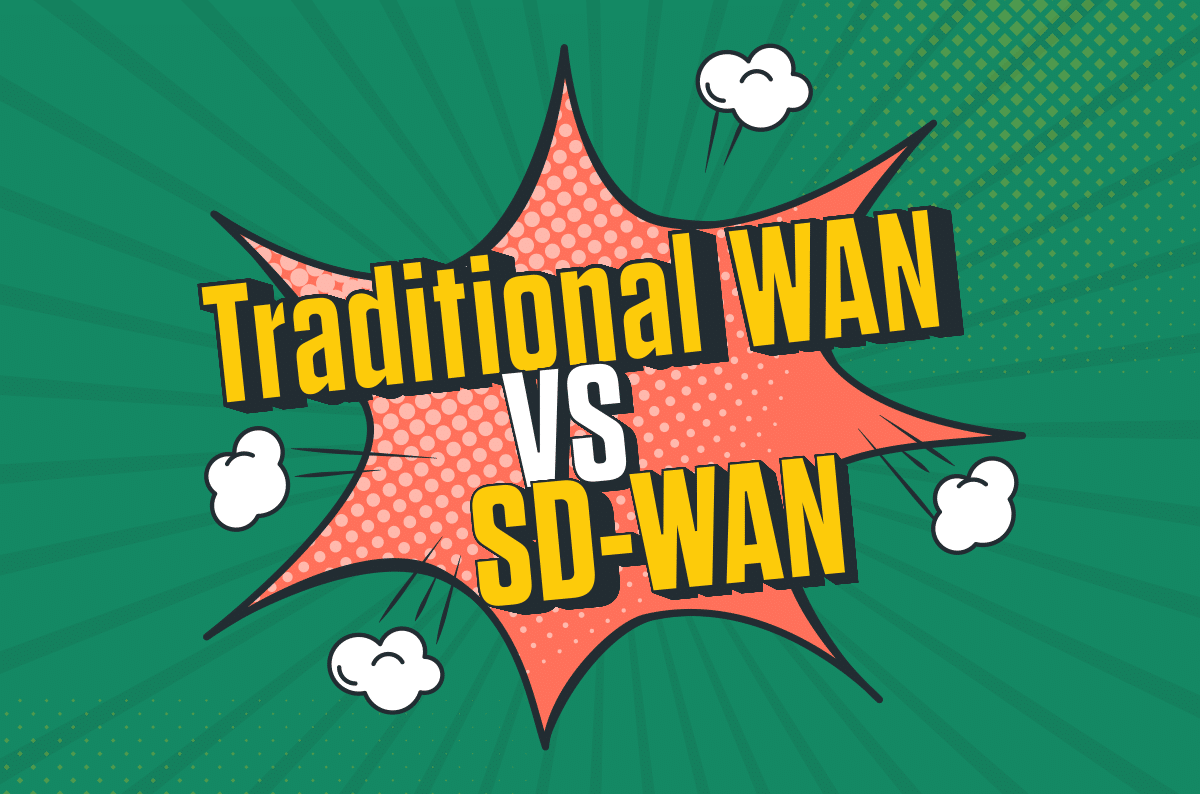|
Listen to post:
Getting your Trinity Audio player ready...
|
The corporate WAN connects an organization’s distributed branch locations, data center, cloud-based infrastructure, and remote workers. The WAN needs to offer high-performance and reliable network connectivity to ensure all users and applications can communicate effectively.
As the WAN expands to include SaaS applications and cloud data centers, managing this environment becomes more challenging. Companies reliant on a traditional WAN architecture will seek out alternative means of connectivity like SD-WAN.
Below, we compare the traditional WAN to SD-WAN, and explore which of the two is better suited for the modern organization.
Traditional WAN Overview
WANs were designed to connect distributed corporate locations, traditionally, with WAN routers at each location. These WAN routers defined the network boundaries and routed traffic to the appropriate destination.
Key Features
Some of the key features that define a traditional WAN include the following:
- Hardware Focus: Traditional WANs are built using hardware products such as routers to connect distributed locations..
- Manual Configuration: Heavy manual configurations is characteristic of traditional WANs. While this provided a high level of control over policy configurations, it also introduces significant complexity, overhead, and potential misconfigurations.
Benefits of Traditional WAN
Traditional WANs have a long history. There are several beneficial reasons for this, including the following:
- Security: Dedicated leased lines ensured strong security and privacy since no two enterprises shared the same network connection.
- Reliability: These dedicated links provide much higher reliability than network routing over the public Internet.
- Control: Traditional WANs gave organizations complete control of their network and allowed them to define routing policies to prioritize traffic types and flows.
Limitations of Traditional WAN
While a traditional WAN can effectively connect distributed corporate locations, it is far from perfect, especially for the modern enterprise. Some of its limitations includes:
- Cost: MPLS connections are expensive and have hard caps on available bandwidth.
- Agility: Modifications and upgrades require extensive manual intervention, limiting their ability to adapt to changing business requirements.
- Scalability: Reliance on hardware also makes them difficult to scale. If an organization’s bandwidth needs exceed the current hardware capacity, new or additional hardware is required, and this can be a slow and expensive process.
- Complexity: Traditional WANs are defined by complex architectures. Managing these is difficult and can require specialized skills that are difficult and expensive to retain in-house.
- Cloud Support: Cloud traffic is often backhauled through the coroporate data center, resulting in greater latency and degraded performance. This is a serious problem as more organizations migrate to Cloud.
SD-WAN Overview
SD-WAN is best defined by: 1) Routing traffic at the software level, and 2) SD-WAN appliances’ ability to aggregate multiple network connections for improved performance and resiliency.
Key Features
Some of the key features of SD-WAN includes the following:
- Software Overlay: SD-WAN creates a software overlay, with all routing decisions made at the software level. This allows the use of public internet for transport, which reduces networking costs.
- Simplified Management: Most SD-WAN solutions offer centralized management for deploying and monitoring for all functions, including networking, traffic management, and security components and policies.
- Increased Bandwidth: Organizations can increase available bandwidth with widely available broadband offerings and ensure optimal network and application performance.
Benefits of SD-WAN
Many organizations have made the switch from traditional WANs to SD-WAN. Some of the benefits of SD-WAN include the following:
- Cost Savings: One of the main distinguishers and advantages of SD-WAN is that it does not require dedicated connections and used available broadband. This generates significant cost savings when compared to traditional WANs.
- Flexibility: With SD-WAN, the network topology and architecture are defined in software, resulting in greater flexibility in configuration, changes and overall management.
- Scalability: Because SD-WAN is a virtual overlay, scaling required bandwidth when business changes dictate it can be made quickly and easily.
- Software-Based Management: Operating at the software level, many management tasks are made easier through automation. This reduces the cost and complexity of network management.
- Cloud Support: SD-WAN provides direct connectivity to cloud data centers, eliminating backhauling and reducing latency. This is essential for the performance of corporate apps migrated to cloud and for SaaS applications.
Limitations of SD-WAN
SD-WAN has become a popular WAN solution, but it still has limitations, including the following:
- Reliability and Performance: Reliance on public Internet to carry traffic can result in unpredictable reliability and performance since the performance of SD-WAN depends on that of the unreliable public Internet.
- Security: SD-WAN typically has basic security, so defense against advanced threats does not exist. This requires the organization to purchase and install next-gen firewall appliances, which increases the hardware complexity in their environment.
Traditional WAN vs. SD-WAN: The Verdict
Both options serve similar purposes. They connect distributed locations and carry multiple traffic types. Additionally, both solutions implements QoS and traffic prioritization policies to optimize the performance and security of the network.
That said, legacy WANs don’t offer the same benefits as SD-WAN. A properly designed and implemented SD-WAN can offer the same reliability and performance guarantees as a traditional WAN while reducing the cost and overhead associated with managing it. Also, SD-WAN offers greater flexibility and scalability than traditional WANs, enabling it to adapt more quickly and cost-effectively to an organization’s evolving needs.
Traditional WANs served their purpose well, but in today’s more dynamic networking environment of cloud and remote work, they are no longer a suitable option. Today, modern businesses implement SD-WAN to meet their more dynamic and ever-evolving business needs.
Migrating to SD-WAN with Cato Networks
The main challenge with most SD-WAN solutions is that their reliability and performance are defined by the available routes over public Internet. Cato Networks offers SD-WAN as a Service built on top of a global private backbone. This offers reliability comparable to dedicated MPLS while enhancing performance with SD-WAN’s optimized routing. Additionally, Cato SASE Cloud converges SD-WAN and Cato SSE 360 to provide holistic security as well as high performance.
Learn more about how SD-WAN is evolving into SASE and how your organization can benefit from network and security convergence with Cato.










